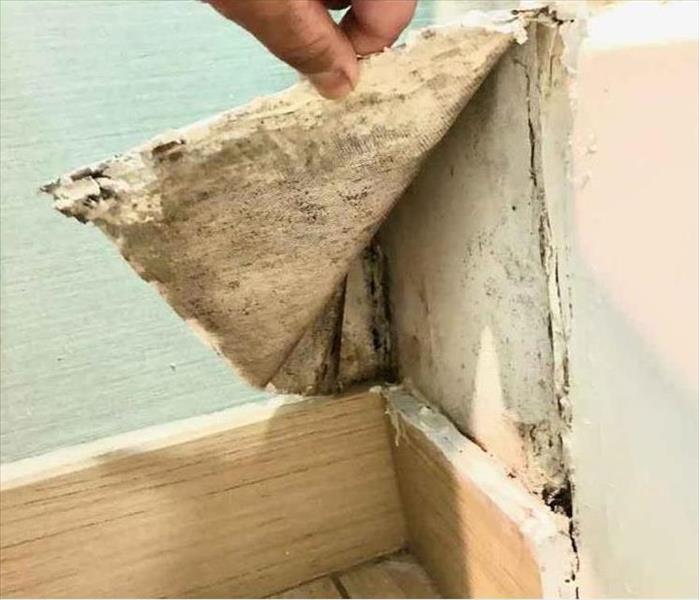Common Causes of Mold in Orlando Hotels and Resorts
3/4/2021 (Permalink)
 Wallpapers in hotels block the wall from breathing and modifying its temperature which can lead to mold growth.
Wallpapers in hotels block the wall from breathing and modifying its temperature which can lead to mold growth.
Mold in Hotels and Resorts
Mold usually comes with a strange and damp smell that you can easily know. If you enter a hotel or resort in Orlando and notice a musty odor, mold could be the issue. Biological contaminants can affect all hotels, including the five-star ones. Here are the root causes of mold in such establishments.
Water Damage
The primary root cause of mold in Orlando hotels and resorts is water damage. Typically, moist thrives in a moist indoor environment. The damage emanates from roof leaks, flooding, pipe bursts, and window leaks. Silent water leaks in the building lead to massive mold growth. Pools of water can reach the carpet where the spores will develop with sheer simplicity. Hurricane aftermaths are also the reason why hotels have a moldy smell.
Mold needs a wet place for 24 hours before it proliferates. If the hotel isn't cleaned within that time, the damages become irreversible. The good news is that you can contact us for restoration. We use specialized equipment to dry out the whole place. We will check for any leaking pipes and roofs for immediate repairs.
Condensation Build-up
Condensation results from drastic temperature changes in the room. For example, if someone gets to the room and leaves the AC on, it will become cold. Another occupant will turn off the unit leading to a different temperature setting. Condensation will occur, attracting mold in the rooms.
Similarly, during the winter, condensation happens on cold surfaces due to temperature inconsistencies. Wood, drywall, tiles, and bricks are prone to the issue. As a result, biological spores will grow since the specific zones are the perfect environment to flourish.
Poor Ventilation
Poorly-ventilated Orlando hotels and resorts are magnets for mold growth. Lack of ventilation also spreads the spores to other areas in the room with sheer simplicity. When the management asks the staff to turn the air conditioner off, there is poor air circulation. The whole place becomes humid, especially during the summer. It is crucial to save on energy bills, but turning off an AC is the worst idea.
The unit needs to be on so that the dehumidifier can get rid of excess moisture in the air. Steamed baths and cooking appliances in hotels contribute to humidity that needs elimination through ventilation.
Wet and Damp Clothes
Wet towels, bathing suits, and clothes lead to mold development in hotels and resorts. Some employees take the clothing out of the washing machine and set them aside to hang the clothes later. The bad news is that they will forget them, and the damp clothes will sit for 24 hours or more. The time-lapse alone will attract mold and spread them to other zones.
When customers check out of hotels, they leave wet towels on the bed. Failure to clean the rooms and pick the towels leads to instant biological contaminants after one day. Spring and summer aggravate mold issues since the air is already humid.
Wallpapers
Wallpapers decorate the hotel rooms, but they contribute to mold. Usually, walls go through temperature changes as the outdoor environment shifts. Wallpapers block the wall from breathing and modifying temperature as well. This way, condensation occurs between the wallpaper and drywall. Peeling the wallpaper will show you the extent of mold growth.
Using glue as an adhesive makes matters worse since it has nutrients that bolster mold growth and spread. We will look for areas with wallpapers and carry out mold remediation with immediate action.
Leaking AC System
A faulty air conditioner leads to mold due to leaking refrigerant or water. A leaking AC causes mucor, which is an allergenic mold, to thrive due to the condensation. It comes with white patches and circulates quickly if the air filter isn't in excellent condition. Moisture build-up comes from damaged ducts and inadequate piping as well. The environment will be ideal for mold to grow and move to other areas in the hotel.
Non-insulated Water Pipes
Water pipes that don't have insulation lure mold development. The primary reason is that they sweat, leading to moisture in the surrounding walls. If the insulation on the pipe has worn off, the problem could happen as well. You might notice that paint on the walls is peeling, indicating mold presence. Typically, the insulation traps the moisture so that it can't seep through the walls and damage them.
If you have any mold issues, contact us for remediation and restoration. We will locate the moisture or water sources for a lasting solution.





 24/7 Emergency Service
24/7 Emergency Service